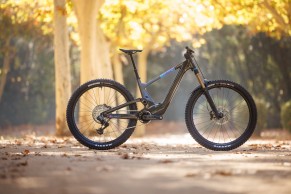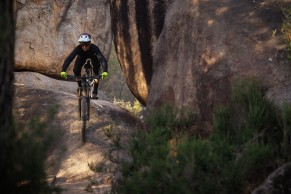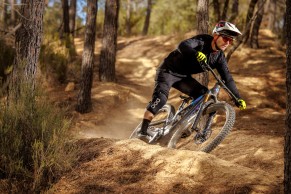We tested the new SCOTT Voltage eRide: advanced technology at the service of fun
The new SCOTT Voltage eRide has just hit the market and it comes as one of the most advanced electric mountain bikes for Trail riding at the moment. Just by looking at it, you can tell it's a very special model, but we've had the opportunity to test it during several sessions and here we share our impressions.

News and key features of the Scott Voltage eRide
With 160mm of travel in the front and 155mm in the rear, modern and customizable Trail geometry, NUDE shock with three different modes, a motor that assists us with up to 50Nm, and a really lightweight for an eBike. The truth is that the new Scott Voltage aims to dominate all terrains, and it has plenty of arguments to do so.
First of all, the concept of a lightweight eBike is gaining prominence and many brands are betting on it. Scott already launched its Lumen model a year ago, a bike focused on a more road-oriented use, between XC and Trail. Now with the Voltage, it enters fully into the more aggressive Trail segment.
RECOMENDADO

How many calories are burned when cycling

What is heart rate variability and how does it affect the cyclist?

Fat Max Training to efficiently eliminate fat

Change wheels if you want to transform your bike's behavior

What bike size do you need? Here's how to find out

How does age affect performance and recovery?
These types of eBikes fit perfectly into the profile of a rider who enjoys pedaling but wants to be able to enjoy the trails without limitations.

The Scott Voltage is equipped with the TQ HPR50 motor, which is becoming a reference when it comes to lightweight eBikes. With an outstanding power-to-weight ratio, as it announces a weight of 1800 grams for the maximum 50Nm of torque it offers. Additionally, this motor is designed to offer a pedaling sensation as natural as possible and aims to achieve a feeling of total absence of friction when the assistance is turned off.
The internal battery that the Voltage carries has a capacity of 360Wh, but it is important to note that the TQ motor demands less energy than a traditional motor and that the bike weighs less than a standard eBike, which means that the autonomy is not as limited as one might think. But just in case, the system contemplates the use of a range extender, which can be mounted instead of the second water bottle and provides an extra 160Wh.
This range extender comes standard on the top-of-the-line Voltage eRide 900 SL, for the rest of the models it can be purchased separately.
In the geometry, we find a modern bike that enhances above all the ability in descents, but without forgetting that we have to climb after each trail. With this goal in mind, we find a seat tube angle of 77.1°, which places us in an optimal position for climbs.
The head angle goes up to 63.9°, which promises great stability at high speeds. The reach of 457mm in size M is in line with current trends and combined with the stem mounted on the Voltage, 40mm in sizes S and M and 50mm in larger sizes, will place us in a comfortable position to have maximum control.
Regarding the Genius model, there are very few variations, the most notable being a slight increase in the length of the chainstays, which goes to 455mm and the bottom bracket is slightly higher at 350mm.
Of course, the Voltage, as is customary with Scott, has the possibility of adjusting the head angle by turning the cups 180°. This allows us to vary by +6° or -6° compared to the position provided by the neutral cups. The data we provide here is with the option of the highest steering angle.
We tested the Scott Voltage eRide 900 TUNED
We were at a presentation and testing event in Santa Coloma de Farners (Girona), where we also had the opportunity to test the new Ransom, which we recently published.
The bike we tested was the Voltage eRide 900 TUNED model. This designation means that it is the most radical and downhill-oriented version, with a specific configuration of suspensions and slightly more aggressive tires.
Starting with the suspensions, we find a Fox Float X NUDE shock with Factory Kashima inside. This shock, in addition to having an external reservoir or "Piggyback," has a different configuration in terms of operating modes, which we control through the TracLoc remote control. This difference consists of, in the intermediate mode, not acting on the hydraulic system by closing the compression, but only closing one of the positive air chambers, reducing the volume and therefore increasing the progressivity. The sag point varies slightly favoring the pedaling position.
This mode is designed to favor pedaling, as the suspension becomes firmer, as well as for those descents where that extra firmness and progressivity come in handy.

In the fork, this Voltage 900 TUNED version mounts a Fox 36 Float Factory Kashima with Grip2 cartridge. The fork does not have remote lockout but has multiple adjustments that allow you to fine-tune the feel and behavior to adapt to the conditions and preferences of each rider.
In this bike, we have a Sram AXS Eagle Transmission, in its GX version, although with a Rocker shifter and not the new POD Controller. We were impressed by the shifter, which felt even more robust than its higher-end counterparts, with the battery housed differently, providing more protection. However, in the case of the Voltage, instead of using the standard battery, it has a wired adapter to draw power from the bike's battery.
The Sram Code Silver Stealth brakes, in addition to ensuring powerful braking, fit perfectly in the cable routing configuration of the Voltage. A key piece in this cable routing is the Syncros Hixon IC Carbon cockpit, which not only promotes integration but also contributes to the aesthetics of the Voltage with its attractive shapes.
In the design of the Voltage, they have taken into account leaving space for long-travel seatposts, so in our test bike, size M, we have a Syncros Duncan seatpost with 180mm of travel.
To finish the assembly, we have a set of Syncros Revelstoke 1.0 wheels, which feature a carbon rim with 30mm internal width and DT Swiss 370s hubs.
Mounted on these wheels are Maxxis tires, combining the Dissector model on the rear wheel with the Assegai on the front, both in 2.6" size.
First impressions
As soon as we approached the Voltage, we couldn't help but admire the integration work done. Having the shock inside the frame, especially with a considerable travel, is already impressive, but in the Voltage, we also have a motor that, if not paying close attention, goes completely unnoticed.
For suspension adjustment, we have the convenience of the sag indicator next to the bottom bracket, which has a gauge that records the achieved sag. Starting from an initial pressure table, it is easier than ever to check if we are at the correct sag and making any adjustments is simple, as by opening the cover at the bottom of the frame, without the need for any tools, we have access to all the shock adjustments.

The Fox fork, with the Grip2 cartridge, allows for total customization, although as time was limited, we relied on the adjustment tables that provided a good starting point and then it was easy to make any adjustments on the go.
Once these initial adjustments were made, we set off.
After a few flat meters, we faced a long climb to access the trail area. We had time to test the TQ motor modes and also to see how the Voltage feels with the assistance turned off.
The Voltage is the closest thing to riding a normal MTB. We didn't notice any friction with the motor off, and pedaling feels super natural, although we are on a bike that exceeds 18kg, so the assistance is welcome.
To control the assistance level, we have a fairly minimalist remote control next to the grip, and the display is located on the top tube of the frame, so no additional device is added to the cockpit area. This display has different screens that can be customized through the app and shows the selected assistance mode with a simple and visual icon.
In the lowest assistance level, it is difficult to perceive clearly that we are on an electric bike, we just notice that we are pedaling with ease on uphill terrain. In this level, if you are not in a group that demands you to go faster, and you enjoy the effort of pedaling and the pure sensations of an MTB, you can tackle almost all climbs. But that wasn't our case in the test sessions we had, as we wanted to ride as many trails as possible, so we used the intermediate mode quite a bit.
As for noise, it is really difficult to perceive the sound of the motor. Even with the assistance at maximum, we only hear the tire rolling and nothing else.

The position we adopt on the Voltage, with the seat tube so vertical, helps us transmit our power to the pedals very effectively on climbs, and with the TracLoc, we adjust the shock to the terrain ahead.
Although the intermediate position in this specific shock model does not act on the hydraulic system and only on the air chamber, as we have explained, the oscillation is minimized in this mode, and on climbs through more or less irregular terrain, we use it quite a bit, reserving the lockout for very smooth trails or asphalt, where that almost complete lockout allows us to pedal with great efficiency and even stand up, something we don't usually do on eBikes due to the weight and the unnatural pedaling sensation they usually offer, but in this type of lightweight eBikes like the Voltage, it makes much more sense.
The Scott Voltage is pure fun on the trails
The most anticipated moment arrived, and it was time to discover the trails that were prepared for us.
From the first descents, we adapted very easily to the Voltage. Improvising in each turn, as we didn't know the terrain beforehand, the bike was easy to handle with astonishing ease.
One of the keys of the new generation of Scott bikes with integrated shock is its low center of gravity, beyond aesthetics or other considerations, it is the most palpable thing while riding. And if we are on a bike that has that added weight in the bottom bracket due to the motor, this fact is accentuated. This way, the Voltage moves much better than its over 18kg would suggest.

What we do need a little more adjustment for is the seatpost pushbutton. The TracLoc control, like the TwinLoc, has three levers. Two are for suspension (locking and unlocking) and the third for operating the seatpost. Although it is well designed, it takes some time to automate the gesture and not make a mistake when operating the seatpost in urgent situations.
In this first test session with the Voltage 900 TUNED we rode down all kinds of trails. Including some more broken and aggressive where the suspensions had to work and they did it with note, allowing us to release the brakes with total confidence.
Also in very steep areas we had the advantage of having a seatpost with 180mm of travel which, coupled once again with the low center of gravity of the Voltage, allowed us to pass these areas with ease.
One of the last descents of this session had many jumps and, despite not knowing the terrain well, we felt completely confident because the Voltage is very stable and docile in the air.
We spent the whole morning making sure we didn't use more battery than we should have so as not to run out of power. We used the maximum assistance mode at specific times to climb steep hills or steep areas and, despite not having the verve of a more powerful engine, the truth is that, thanks to the efficiency of the Voltage and its relatively low weight, we did not miss it.
In the end we were too cautious, because we finished the session with almost 30% of battery remaining, but some of the companions did use it up and could check how you can finish the route without any drama, although suffering a little more, of course, and checked that the change continued to work until you reach the destination.
During more than two hours that we stopped to eat something and attend part of the presentations that we did about the Voltage, the bikes were in charge and we checked that in a short time they reach almost 100%.
For the next session, in addition, we took the range extender placed on the frame.
In this afternoon session we were not so careful with the battery and enjoyed the trails to the fullest. We also repeated some of those of the morning and so we were able to descend faster, feeling more and more attached to the Voltage.

When the range extender is used, the engine is powered by the range extender, leaving the internal battery on the sidelines, until it is completely depleted. A curious detail is that this moment is noticeable, because for two or three seconds the assistance is lost, and we had to check it in full climb. The engineers call it the "hand shake" that both batteries give each other.
As for the setup of this Voltage, once again Sram's Eagle Transmission delivered with flying colors. It was the first time we tested the GX version and the truth is that we did not notice any differences in performance compared to the higher ranges. On an eBike it is a plus to be able to shift without having to slacken the slightest and the precision is impeccable. We love the choice of the previous control in its Rocker version, although it is a matter of taste.
We also really liked the combination of Maxxis Assegai and Dissector tires, which gave us a lot of security and really got us out of trouble when we saw the limit very close, because of not knowing the terrain.
Conclusions
Although it was not a long test, we were able to take advantage of the time and there were several quite intense sessions, in fact, despite being an eBike, we ended up quite tired. This is one of the keys to this type of bike. The Voltage does not do everything for you.

If you are looking for an eBike that doesn't make any demands on the climbs and just wants to ride downhill and let the motor do all the work, you won't find the Voltage the ideal bike for you. The Voltage is for the biker who enjoys all aspects of MTB but wants the extra "joy" to either do as many descents as possible, or simply ride a demanding route where you can go further and enjoy a bike with great capability when the terrain gets tough.
Scott Voltage eRide 900 TUNED: specifications and weight
- Frame: Voltage Carbon HMF, virtual 4 link, 155mm
- Fork: Fox 36 Float Factory Kashima Grip2, 160mm
- Shock: Fox Float X NUDE Factory Kashima EVOL, Piggy Back, 3 modes
- Remote: TracLoc
- Motor: TQ HPR50
- Battery: TQ 360Wh
- Derailleur: Sram GX AXS Eagle Transmission
- Shifter: Sram GX AXS Rocker
- Crankset: E*Thirteen Carbon
- Chainring: Sram Eagle Transmission 34T
- Chain: Sram CN GX Eagle Transmission
- Cassette: Sram GX Eagle Transmission XS-1275 10-52
- Brakes: Sram Code Silver Stealth, 200mm discs
- Handlebar: Syncros Hixon IC Carbon, 15mm rise S/M, 25mm rise L/XL
- Seatpost: Syncros Duncan, 140mm S, 180mm M, 210mm L/XL
- Saddle: Syncros Tofino 1.5 Titanium rails
- Wheelset: Syncros Revelstoke 1.0-30
- Front tyre: Maxxis Assegai 2,6” EXO+ 3C MaxxTerra
- Rear tyre: Maxxis Dissector 2,6” EXO+ 3C MaxxTerra
- Approx. weight: 18.6kg